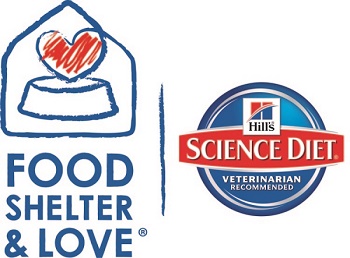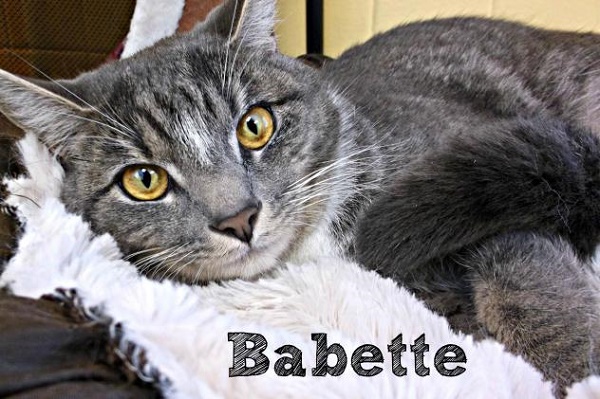This post is sponsored by Hill’s. I am being compensated for helping spread the word about Hill’s® Science Diet® and Food, Shelter & Love® Program, but Daily Dog Tag only shares information we feel is relevant to our readers. Hill’s Pet Nutrition, Inc. is not responsible for the content of this article.
Its no secret that dogs are my favorite animals, and I’m guessing that is the same for most of my readers. Many people are under the impression that cats and dogs can’t coexist peacefully, but that isn’t necessarily true.
 While cats and dogs are different, they share a lot of the same needs: primarily food, shelter and love. They also require veterinary care, exercise, fresh water and grooming. If you are already sharing your space with a dog, you probably have what it takes to have a cat in your life. The cats shown are adoptable from Stevens-Swan Humane Society of Oneida County in Utica, New York, a partner of Food, Shelter & Love.
While cats and dogs are different, they share a lot of the same needs: primarily food, shelter and love. They also require veterinary care, exercise, fresh water and grooming. If you are already sharing your space with a dog, you probably have what it takes to have a cat in your life. The cats shown are adoptable from Stevens-Swan Humane Society of Oneida County in Utica, New York, a partner of Food, Shelter & Love.
 When we first added a cat to our family, we had an only dog, Keesha. None of us knew much about cats. I had always been very suspicious of cats, but it turns out that having a cat in the family is not scary after all. Keesha and Kitty became good friends and I think she enjoyed having another non human in the house.
When we first added a cat to our family, we had an only dog, Keesha. None of us knew much about cats. I had always been very suspicious of cats, but it turns out that having a cat in the family is not scary after all. Keesha and Kitty became good friends and I think she enjoyed having another non human in the house.
Not every dog should have a cat in the house, so please keep that in mind when you consider adopting a cat. Although we were advised that Theo was cat aggressive, he and our cat are respectful of each other and I’ve observed them sleeping next to each other on several occasions. I believe by setting ground rules early and careful supervision, Theo learned to adjust to living in a house with a cat fairly easily.
Here are a few tips to help make the first introductions easier. The time it takes is really dependent on the individual animals.

1. Separate animals: create a safe haven for cat away from dogs, complete with bed, litter box, food, water and some human companionship if the cat is comfortable with people.
2. Big changes can be stressful. Many pets are understandably stressed in the shelter and their first few weeks in a new home. That stress can affect their digestive system, so Hills has developed Hill’s® Science Diet®Adult Sensitive Stomach & Skin which provides is formulated for sensitive digestive systems and improves skin and coat health.
3. After the cat is acclimated to safe spot, switch blankets and/or beds between cat and dog, allowing them to become acquainted somewhat with the other animal.
4. Introduce the cat to the rest of the house while the dog is outside or sequestered in another room. Let the cat discover hiding places (add a small crate or box if you house doesn’t have a hiding spot) and wait until he begins to feel comfortable in other parts of the house. (This may take a few hours or a few months depending on the cat.)
4. Allow the cat and dog to interact while supervised. A baby gate may be the perfect barrier for an initial interactions. I recommend taking your dog for a long walk before the first introduction. Keep dog on leash for the first face to face meeting so that if a problem arises, you can intervene quickly and safely.
5. Continue monitoring. Never leave pets unsupervised until you are sure it is safe.
6. One thing cats and dogs should not share is the same pet food. Each species has its own unique nutritional needs. Hills Science Diet is available from your vet, various specialty shops and it online from Pet 360.
You might be able to find the purrfect companion for you and your dog in one of Hill’s shelter partners.

Hill’s Food, Shelter & Love program has provided over $275 million worth of food to more than 800 shelters across the country, feeding over 7 million pets. Additionally Hills has a disaster relief network providing food to both shelter pets as well as pets temporarily displaced from their homes due to natural disasters.
https://youtu.be/yAAPzLAhK-w
Everyone needs #FoodShelterLove, thanks to Hill’s for helping so many pets!







I know Hills is helping the shelters after the tornadoes. Bless them for all caring and helping!
What Gorgeous kitties! My Husky loved our cat to pieces, it was so sweet. Hill’s rocks with their wonderful Food, Shelter, & Love program. It helps so many pets & families.
Love & Biscuits,
Dogs Luv Us and We Luv Them
Great tips!!! Never rush it and don’t be afraid to start over.
That is a great point Brian,I know you have a lot of experience bringing cats into a new environment!
Great post! So grateful to Hill’s for their help during disasters, as well as the great food.
I can’t even imagine how awful it must be to lose so much. I’m glad that Hill’s is there to help pets when a disaster strikes!
It amazes me to hear a dog losing 9 pounds. My guys don’t weigh much more than that. We do love to hear about dogs who are at a healthy weight.
I hope all those adorable kitties get adopted soon.
Me too! Thanks for stopping by.
I really enjoyed reading through your tips for introducing cats to your house when you have dogs. One important tip that you mentioned that cannot be stressed enough is to not feed your dogs and cats the same food. Introducing your cat to the rest of the house while the dog is outside is really great too. New smells alone can be quite overwhelming for an animal. They do not need the added stress of an animal in their face when they are trying to explore. Thanks again for an interesting article!
Thanks for stopping by and commenting!
I didn’t realize that cat and dog food were so nutritionally different from each other until we got a cat.